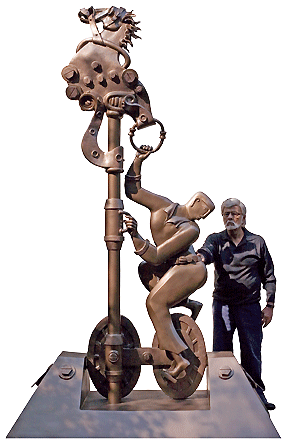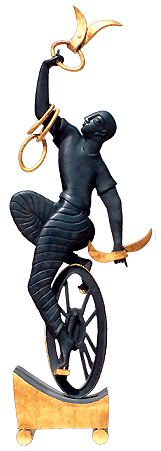- Prelude
- Editorial
- 'Public Sculptures are the Public's own Consciousness'
- Stimulating Thoughts
- Sculptural Traditions and Contemporary Art Practices
- Sculpting out a Third Dimension from Madhya Pradesh
- About Nostalgic Dragonflies and Homes in the Bags: Sculptural Snapshots from the North-East
- A Concise Chronicle of Bengal's Modern Sculpture
- Neo-sculptural Identity: Six Young Sculptors
- From Object to Experience: Notes on American Sculpture
- In the Domain of Drama Sculptures of S.Nandagopal
- Satish Gujral : Sculpting the Inner Form
- Transformation of Articulations: Mrinalini Mukherjee
- The Experiential Quotient in the Sculptures of Ravinder Reddy
- Shresta Rit Premnath A Passion for Structure
- The Anatomy of Melancholy: Sculptures of Rajesh P Subramanium
- A Crusader of/for Site Specific Public Art: Subodh Kerkar
- Installation Practices in and around Santiniketan
- A Wall is a Screen: A Promenade Film Street Performance
- Jaeger-LeCoultre An Overview
- Regency Style: Regency Furniture
- Designing the Streetscapes: Visual Elements of Pedestrian Corridors
- Sculpture Rules It All
- The Triumph of the Eternal
- Artist Index and Statistics- Anish Kapoor
- Auction Reports
- Musings from Chennai
- Art Bengaluru
- Art Events Kolkata: October-November 2010
- Mumbai Art Sighting
- An Evening of Interaction
- 6th Asian Museum Curators' Conference
- Swedish Art in India
- Couple of Difference : Recent sculptures of Karl Antao
- Previews
- In the News
- Sotheby's : Important Watches Geneva
ART news & views
Satish Gujral : Sculpting the Inner Form
Volume: 3 Issue No: 11 Month: 12 Year: 2010
by Dr. Seema Bawa
Satish Gujral is a consummate artist for whom painting, sculpture and architecture are equal manifestations of a single aesthetic. In his artistic worldview the art forms are “determined by the force of necessity, all three are locked together in a common structural frame work, measure and proportion, system of movement, sonority and echo. It is this homogeneity that has made the dream of achieving a synthesis of the three, almost an old as has been their isolation from each other.” It is no wonder then that sculptures have played such a significant role in his artistic growth. His sculptures have synthesized movement of life and industry with the stillness of the soul, the darkness of dense material with the luminosity of enlightenment, of playfulness of an artist with the wisdom of the experienced sage.
His recent sculptures can only be termed monumental, rising up to twelve feet and yet their towering verticality has a lightness of being, reaching out towards the spiritual, the divine. In this series he has melded man and machine into a unified energy matrix; the mechanical and biological confront and complement each other. The artist remarks that these make forms make him feel “more akin to the present age.”
In this series he has melded man and machine into a unified energy matrix; the mechanical and biological confront and complement each other. The artist remarks that these make forms make him feel “more akin to the present age.”
He had previously created some of the same sculptures on a smaller scale but felt that the increased size will be able to give greater expression to this form. In fact, he feels that perhaps they could have even been made double their current size; but even the indomitable artist admits that logistical constraints sometimes restrain ones creative instincts, for example how would one transport and where does one exhibit such large works.
Though Gurjal was not formally trained in sculpture, he was fortunate in getting primary training at the Mayo School of Arts where John Lockwood Kipling was the principal. The curriculum in this institution was predicated on the belief that all three- painting, sculpture and architecture are arts of ‘space’. They represent an artist’s attitude towards spatial organizations. They could not exist in a vacuum nor fully develop in isolation from each other. Gujral does not have to drop one medium to start on another. There have been times that he has worked on architecture, painting and sculpture simultaneously though in the last ten years he has eschewed architecture he continues to be an avid sculptor, though he admits that architecture has helped him in approaching and internalising form.
Gurjal has been inspired with the play of space in architecture, but feels that each art form should be approached from its individual perspective. Thus he perceives sculpture strictly in sculptural terms. He reached this conclusion after observing Le Corbusier with whom he was associated with in the designing of Chandigarh. Le Corbusier called architecture “form in air” where “an idea is subordinated by the form.”
Additionally, Gujral started his early artistic career in Mexico under Siqueiros and Diego Rivera who were practicing the public art in form of murals. Besides being influenced by the ideological underpinning of mural as an art form, Gujral realised that the mural is a combination of sculpture and painting. Murals have a third dimension and this element led the artist towards exploring sculpture as a medium for his artistic expression. From the 1960's, soon after his return from Mexico, along with his paintings Gujral began to create free standing sculptures.
While creating a sculpture, Gujral does not begin with an idea. He lets his feeling convert itself into form. Form is not guided; it grows out of a feeling. He elucidates, “If an idea comes before form then it is as unlikely as an arrow that reaches its target before its sound; only after a baby has been born that we think of a name.” This is one of the reasons that the artist does not give any title to his forms, he wants to allow the beholder to find own form in the sculptures. He is convinced that art should liberate and not enslave either the artist or viewer.
Even before the form may emerge, many a times the artist is provoked by a medium. He recalls that when Louis Kahn was asked as to why he was working in brick for his building in Ahmedabad, the architect responded “that I conceived a form and then I asked it what material it wanted to be clad in and it replied brick.” For sculpture Gujral, similarly, feels that that a certain form needs a particular medium.  His shift from one material to another is part of his adventurous creative nature and in his long career he has worked in burnt wood, plain wood, fiber glass, and ceramic as well as bronze.
His shift from one material to another is part of his adventurous creative nature and in his long career he has worked in burnt wood, plain wood, fiber glass, and ceramic as well as bronze.
Lest it be thought that medium is only a superficial change, for Gujral this shift from one medium to another is crucial to his creative process and has sometimes been impelled by form and sometimes stemmed from observation of things and life forms. He never predetermines what he will be creating in the future for he says, 'If I know what I will be doing tomorrow I will do it today.” Thus the experimentation and creation of new forms in different mediums has an organic evolution starting from lived reality and delving into the very essence of the substance.
This is exemplified by his burnt wood sculptures. Once at Lohri the artist was struck by the beautiful pink, red and multi coloured cinders emerging from a burning log. Both the texture and colour attracted him, and immediately he knew that he wanted to work in burnt wood. He did not know what he wanted to create but only that he wanted to work in burnt wood like Vincent van Gogh said to his brother Theo “ I want to paint red, I want to paint red, I want to paint red with all the passion in my heart.” Gujral too was obsessed with the sooty blackness of burnt wood from which he then created deities and other forms interspersed with a hint of vermillion and gold like the glowing embers of the elemental fire. The medium was particularly suited to the interplay of tradition with contemporary sensibility which Gujral infuses into it.
He was once walking in the back lane of his house when he came across a group of buffalos with bells around their necks. He was attracted to the curious texture of the metal. After making enquiries he realized that the texture came from the rough and ready technique of poor people who could not afford brass and instead would buy junk metal, grind it to make a powder and then melt this onto a tin plate. This gave the metal its texture and peculiar patina. This discovery marked the birth of his metal sculptures in which he worked for over a decade.
But before Gujral could become complacent in metal and burnt wood, he arrived at the third phase of his sculptural journey, and started exploring the colours and textures of granite. The play of many shades of grey and differing depths of carving give the animal and human forms in granite a tactile quality.
For the last ten years, since he abandoned stone, the artist has chosen bronze for his sculptures. He first moulds his forms in clay which allows him the freedom to turn them around. More importantly for the artist in bronze, like in ceramic, he has the option of playing with patinas. “The variety of colours is bewitching” admits the artist, this along with the serendipitous discovery of the final product mesmerize him. Just as a mother cannot see her baby before it is born, in ceramic one can only know the colour after opening the kiln, and in bronze the final appearance cannot be predetermined. The patina creates its own feeling; in fact the artist feels that dissimilar patina can impart different character to two similar pieces having the same form.
Change defines Satish Gujral’s art whether it is his painting or his sculptures. He has never submitted to the concept that once one has created a style one is sold to it. According to him a style must not enslave you. He feels that “like a medium, style is encaging because it curbs your freedom to choose and therefore he changes not just the thematic, but the very language of his art every few years. He avers that “I have always lived in my own image and not an image others have of me. Once you learn to change, no other consideration can stop you.”
Over the decades, deities, tribal forms, geometrical projections, animals and humans, entwined harnesses and now mechanical devices and human forms have been the subject of his sculptures. All have been infused with the artist's original vision and energy, never stale and ever relevant.
Over the last half a century, Satish Gujral’s sculptures represent a dynamic dialectic with the changing milieu on the one hand and the deeply personal need to continually seek a changing vocabulary for his art on the other.